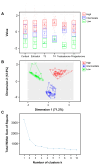Association between Salivary Hormones, Dental Caries, and Cariogenic Microorganisms during Pregnancy
- PMID: 38892893
- PMCID: PMC11173116
- DOI: 10.3390/jcm13113183
Association between Salivary Hormones, Dental Caries, and Cariogenic Microorganisms during Pregnancy
Abstract
Objective: This study aimed to identify the salivary levels of six hormones (progesterone, estradiol, testosterone, cortisol, thyroxine T3, and triiodothyronine T4) in pregnant women, and to assess the association between salivary hormones, dental caries, and cariogenic microorganisms. Methods: This cross-sectional study included 181 low-income US pregnant women who were in their third trimester. Demographic details, oral hygiene practices, and medical backgrounds were obtained via questionnaires and medical records. Calibrated dentists obtained data on plaque index and caries status through comprehensive oral examinations. Unstimulated saliva was collected 2 h before eating and brushing. Salivary hormones were measured with a multiplex assay. Oral Streptococcus mutans (S. mutans) and Candida albicans (C. albicans) were quantified via colony-forming unit (CFU) counts. A latent model was used to generate clusters of pregnant women based on salivary hormone levels, followed by post-clustering analysis. Factors associated with salivary cariogenic microorganisms were further evaluated via multiple regression analyses. Results: Estradiol, progesterone, testosterone, cortisol, T3, and T4 in saliva were detectable at rates of 92%, 97%, 77%, 99%, 71%, and 50%, respectively. Three distinct participant clusters (high, intermediate, and low) were identified based on salivary hormone levels. Intermediate-level and high-level clusters had increased numbers of decayed teeth, decayed surfaces, ICDAS scores, and salivary S. mutans and C. albicans, compared to the low-level cluster (p < 0.05). Covariate analysis demonstrated that the high-level cluster was positively associated with salivary carriage of S. mutans (CFU/mL) (p < 0.05). Participants with higher levels of progesterone, estradiol, testosterone, and cortisol were associated with a high carriage status of S. mutans in saliva (>105 CFU/mL) (p < 0.05). Conclusions: This study demonstrated the feasibility of detecting salivary hormones during pregnancy and revealed the positive association between salivary steroid hormones and cariogenic pathogens.
Keywords: Candida albicans; Streptococcus mutans; caries; hormone; pregnancy.
Conflict of interest statement
The authors declare no conflicts of interest.
Figures



Similar articles
-
Association between Salivary Immune Markers and Oral Health Conditions in Pregnant Women.Res Sq [Preprint]. 2025 Apr 14:rs.3.rs-5968375. doi: 10.21203/rs.3.rs-5968375/v1. Res Sq. 2025. Update in: Sci Rep. 2025 May 6;15(1):15776. doi: 10.1038/s41598-025-99692-4. PMID: 40321779 Free PMC article. Updated. Preprint.
-
Association between salivary immune markers and oral health conditions in pregnant women.Sci Rep. 2025 May 6;15(1):15776. doi: 10.1038/s41598-025-99692-4. Sci Rep. 2025. PMID: 40328948 Free PMC article.
-
Oral health and Candida carriage in socioeconomically disadvantaged US pregnant women.BMC Pregnancy Childbirth. 2019 Dec 5;19(1):480. doi: 10.1186/s12884-019-2618-7. BMC Pregnancy Childbirth. 2019. PMID: 31805881 Free PMC article.
-
Salivary factors related to caries in pregnancy: A systematic review and meta-analysis.J Am Dent Assoc. 2020 Aug;151(8):576-588.e4. doi: 10.1016/j.aime.2020.04.021. J Am Dent Assoc. 2020. PMID: 32718487
-
Variables affecting salivary Streptococcus mutans counts in a cohort of 12-year-old subjects.Minerva Stomatol. 1999 Sep;48(9):361-6. Minerva Stomatol. 1999. PMID: 10638169 Review.
Cited by
-
Association between Salivary Immune Markers and Oral Health Conditions in Pregnant Women.Res Sq [Preprint]. 2025 Apr 14:rs.3.rs-5968375. doi: 10.21203/rs.3.rs-5968375/v1. Res Sq. 2025. Update in: Sci Rep. 2025 May 6;15(1):15776. doi: 10.1038/s41598-025-99692-4. PMID: 40321779 Free PMC article. Updated. Preprint.
-
Association between pica practice, oral health, and cariogenic microorganisms of US pregnant women: A cross-sectional study.Arch Oral Biol. 2025 Jul;175:106277. doi: 10.1016/j.archoralbio.2025.106277. Epub 2025 Apr 29. Arch Oral Biol. 2025. PMID: 40318578
-
Association between salivary immune markers and oral health conditions in pregnant women.Sci Rep. 2025 May 6;15(1):15776. doi: 10.1038/s41598-025-99692-4. Sci Rep. 2025. PMID: 40328948 Free PMC article.
References
-
- Azofeifa A., Yeung L.F., Alverson C.J., Beltran-Aguilar E. Dental caries and periodontal disease among U.S. pregnant women and nonpregnant women of reproductive age, National Health and Nutrition Examination Survey, 1999–2004. J. Public Health Dent. 2016;76:320–329. doi: 10.1111/jphd.12159. - DOI - PMC - PubMed
Grants and funding
LinkOut - more resources
Full Text Sources

